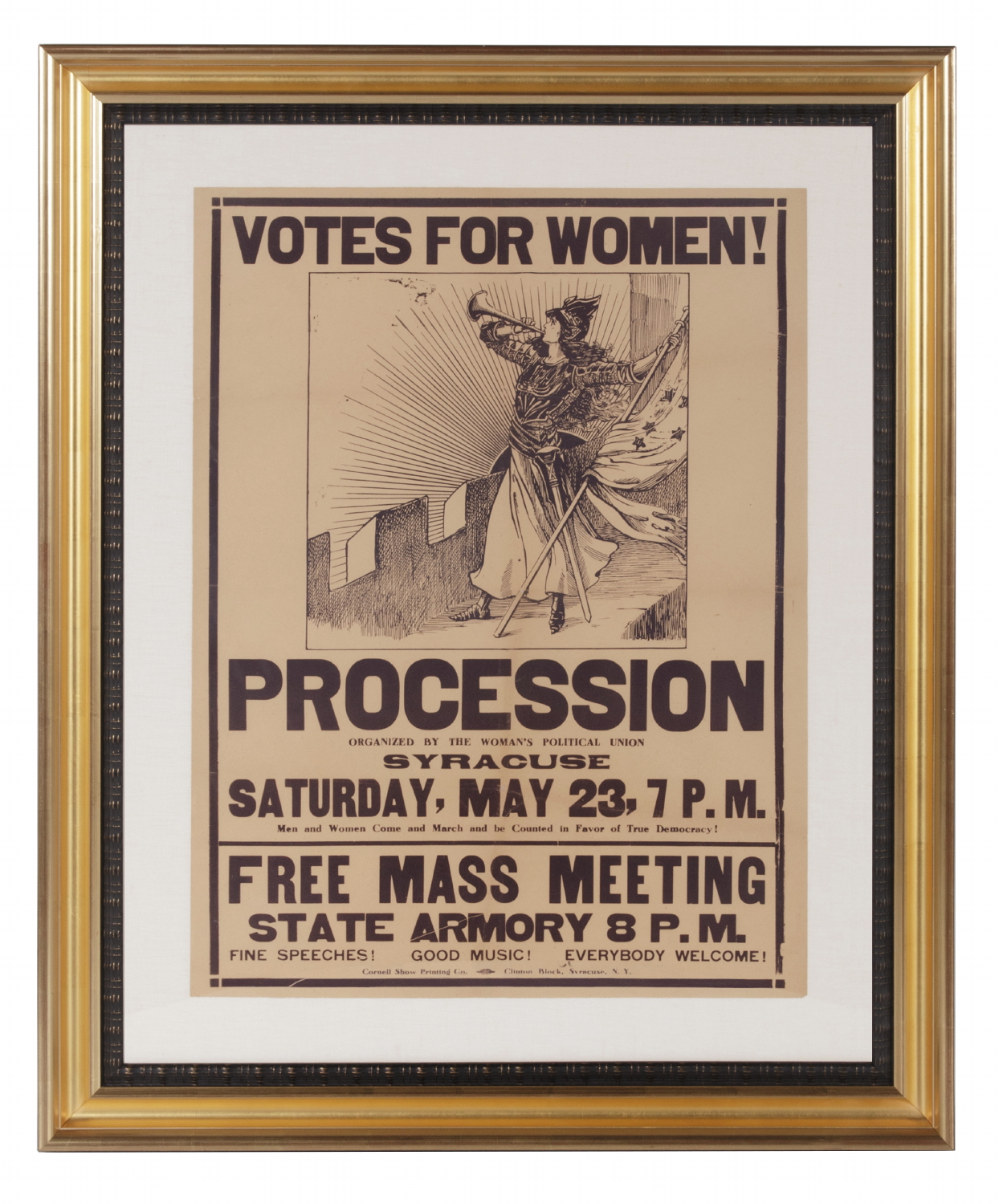
| |
RARE SUFFRAGETTE BROADSIDE ADVERTISING A 1914 MARCH AND SUBSEQUENT RALLY IN SYRACUSE, NEW YORK ORGANIZED BY THE NYC-BASED WOMEN'S POLITICAL UNION, THE ONLY KNOWN EXAMPLE IN THIS STYLE |
|
| Available: |
Sold |
| Frame Size (H x L): |
31.25" x 38" |
| Flag Size (H x L): |
21" x 28" |
|
| Description....: |
|
RARE SUFFRAGETTE BROADSIDE ADVERTISING A 1914 MARCH AND SUBSEQUENT RALLY IN SYRACUSE, NEW YORK ORGANIZED BY THE NYC-BASED WOMEN'S POLITICAL UNION, THE ONLY KNOWN EXAMPLE IN THIS STYLE:
Suffragette broadside, printed in deep violet on a white ground to advertise a 1914 parade and meeting in Syracuse, New York for the Women's Political Union. The imagery features the iconic Bugler Girl or Clarion Girl on the ramparts of a fortress, above which is the simple message "Votes for Women!" Below is the following text:
Procession
Organized by the Woman's Political Union
Syracuse
Saturday, May 23, 7 P.M.
Men and Women Come and March and be Counted in favor of True Democracy!
Free Mass Meeting
State Armory 8 P.M.
Fine Speeches! Good Music! Everybody Welcome!
Underneath is the union bee (standardized mark that the piece was printed with unionized labor), along with the name and location of the printer: "Cornell Show Printing Co.; Clinton Block, Syracuse, N.Y."
Period Suffragette broadsides are particularly rare and sought-after. This one has exceptional graphics and appears to be singular among known examples, as well as unrecorded. Adding to desirability is its bold size, which, while smallish among posters in general, is large and coveted in the world of Suffrage material.
The Bugler Girl has its roots in the English Suffrage movement. It was designed by a British artist and suffragette named Caroline Watts (1868-1919), for a poster advertising a suffrage march in 1908. Watts was an illustrator who worked in the art nouveau style and was commissioned by book publishers David and Marie Nutt. Following David's death, Marie took part in the famous 1907 "Mud March" and afterwards published several books on the suffragette movement, which is perhaps how Watts became involved.
The Women's Political Union was the brainchild of American suffragette leader Harriot Eaton Stanton Blatch (1856-1940). Blatch was the daughter abolitionist Henry B. Stanton and suffrage pioneer Elizabeth Cady Stanton, who served as the first president of the National American Woman Suffrage Association (NAWS) and co-authored the landmark, four-volume "History of Woman Suffrage" with Susan B. Anthony, Matilda Joslyn Gage and Ida Husted Harper. Following graduation from Vassar College, Harriot assisted these women by compiling research for the book. She then moved to England for 20 years, marrying a British businessman. In 1902 she returned to the States and became involved with two significant suffrage groups, the Women’s Trade Union League and the National American Woman Suffrage Association. In 1907, disgruntled with their ineffectiveness and stagnation, she founded the Equality League of Self-Supporting Women, which appealed to the working class. Before this time the suffrage organizations in America were largely represented by socialites, whose numbers could not effectively influence the vote. In 1910 the Equality League changed its name to the Women's Political Union (WPU) and organized America's first large-scale suffrage parade, which took place on Fifth Avenue in New York.
To advertise the activities of the WPU, Harriot borrowed the Bugler Girl, adapting it for the American audience and adding stars to the flag held by the Clarion figure to represent states that passed suffrage legislation. She also adopted the violet, white and green colors of her British suffragette peers. Colors in America were generally yellow and white, but Blatch wanted to distinguish the organization.
In 1915 the WPU merged with suffragette leader Alice Paul's Congressional Union, which later morphed into the National Woman’s Party. On November 2nd of that same year in New York State, male voters defeated a referendum that would have amended the U.S. Constitution to give all women of the state the right to vote. New York was among four eastern states where the issue came to a vote, including New Jersey, Pennsylvania and Massachusetts, all of which were unsuccessful. Public support had been favorable in New York specifically, where the Suffrage movement was 100,000 members strong. Polls had predicted the likeliness of a win, and while it did not occur that year, a successful follow-up campaign in 1917 made New York the first eastern state to adopt suffrage.
Mounting: This is a pressure mount between U.V. protective Plexiglas and 100% hemp fabric. The mount has been placed in a gilded French molding with an early American profile, to which a black, ripple-profile molding with gold highlights was added as a liner.
Condition: There is moderate oxidation throughout, some misprinting and minor loss from fading. There is some creasing. Overall this is simply an excellent state of preservation with respect to the extreme rarity of suffragette broadsides of this quality and thus easily warrants what constitutes minor condition issues. |
|
|
|
| Collector Level: |
Advanced Collectors and the Person with Everything |
|
| Flag Type: |
|
|
| Star Count: |
|
|
| Earliest Date of Origin: |
1914 |
|
| Latest Date of Origin: |
1914 |
|
| State/Affiliation: |
New York |
|
| War Association: |
|
|
| Price: |
SOLD |
|
| |
Views: 2713 |
|
|
|

